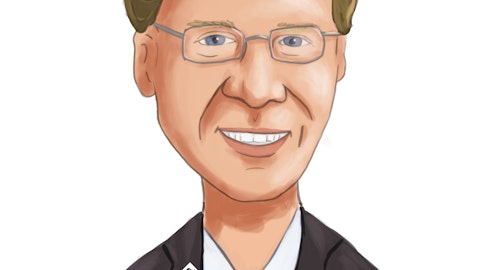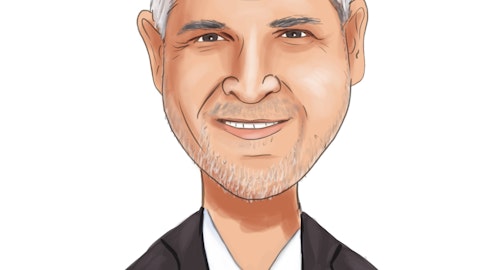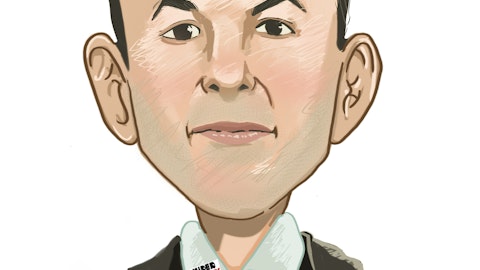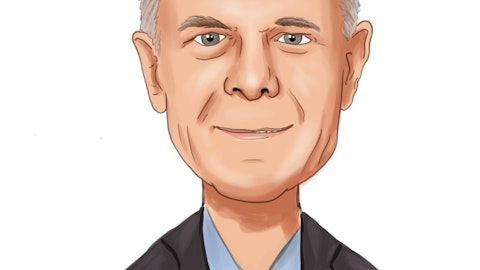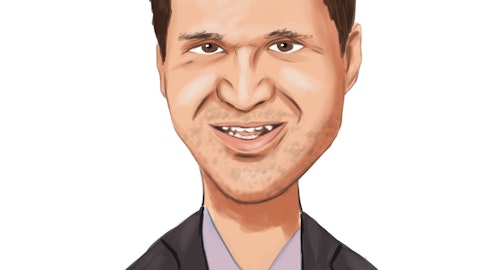And so we still remain cautiously optimistic. And to your point, Bob and his team are trying to look at every different way they can and ring-fence anything that gives us any concerns.Jamie Gregory Yes. And Brad, I’ll just jump in from the allowance perspective. And everything Bob — as Bob mentioned, we’ve done a deep dive on all these portfolios and looked at all loans of any real size and all of that is embedded in our allowance calculation. And so as Bob mentioned, the 10% to 15%, the watch list on our non-medical office, that is included in the allowance calculation. And what you’ve seen is on aggregate, the quality of the loan portfolio has led to a reduced life of loan loss estimate for the past couple of quarters. And so the aggregate portfolio has increased.
In the first quarter, we did increase the allowance based on the CRE portfolio by a little less than $20 million, and that’s embedded in the move from the 1.15 to the 1.17 ACL ratio.Bradley Milsaps Got it. And I guess this is my follow-up. You guys covered a lot there. But you mentioned as you move up in loan size, you also feel like you’re moving up sort of in quality of borrower. Can you just kind of give us a little sense of kind of maybe some of the drivers behind the loan growth, I think you mentioned a couple of times that are seeing maybe larger exposures but certainly in line with — as you become a larger bank, that’s pretty natural. Just curious on any additional color there.Kevin Blair Yes. So it’s — we’ve talked about it in terms of how we continue to grow our balance sheet actually allows us to de-risk the overall balance sheet.
And it’s just based on the fact that as we’re booking more middle-market credits as we moved into corporate and investment bank, we’re more investment-grade credits. And so when you look at it from an expected loss through our provisioning or just through our risk rating process, it would suggest that the production that we’re putting on today and we put on in previous quarters is in effect, reducing the overall expected loss of the portfolio, moving away from, as you suggested, some of these smaller credits that have a little more volatility and less cushions of protection. And so this quarter, our loan growth, obviously, on the CRE front was more of a function of fund ups on our construction lines on multifamily. But on the C&I side, most of the growth came from middle market, which was about 50% of the growth, which is for us, we think right down the middle of credits that are going to perform at a very high level.
So that’s been our plan in terms of growth as we’ve shifted to some of these new specialties and moved up market that not only are we getting good growth, but we’re also derisking the portfolio at the same time.Bradley Milsaps Great, thank you guys. I appreciate the color.Kevin Blair Thanks Brad.Operator The next question is from Ebrahim Poonawala from Bank of America. Ebrahim, your line is open. Please go ahead. Ebrahim Poonawala Hey, good morning. I guess on NII, Jamie, just wanted to follow up on your comments around, I guess, a decline in 2Q and then relative stability in the back half. Just talk to us in terms of dynamics that you expect from there around, one, the pace of deposit repricing if, let’s say, if the Fed is done after the May hike, like how do you expect deposit costs and betas — at what point do they stop rising?
And remind us of just the asset repricing that you expect back half into next year?Jamie Gregory Yes. Ebrahim, as we look forward we do expect to see continued increases in deposit costs as we kind of get to the end of this tightening cycle. When we think about the timing, just like what we said in January, we do expect the first quarter to be our highest quarterly increase in total deposit costs. And when you look at that, you can look at the months of December to March where our costs increased 55 basis points. But thinking about those monthly increases, which we think is probably a better way to look at a little higher frequency data, prior to March we saw a steady trend that was right in line with what we had modeled and what we discussed in January.
We saw monthly deposit cost increasing and those increases peaking in November and December. And then in January and February, we saw steady declines in the rate of increase of total deposit costs along the lines of what we expected.Now clearly March was a little bit of a different story when we saw the disruption and so we did see an increase there. That was actually kind of similar to what we saw in November and December. But the movements that we saw the rollover from year-end into early Q1 gives us confidence in our modeling and our expectations going forward. And so we do believe that we will start to see that trend resume from here of slower increases — monthly increases in total deposit costs, but the March disruption does shift our through-the-cycle beta higher into the low 40s.
And so as we look at the second quarter, we do expect to see total deposit cost increase a little less than 50 basis points. That’s less than the first quarter and about a 30 basis point increase from the month of March numbers. And so that’s what we expect to see in the near term. Then beyond that, we’ll continue to see some marginal increase in deposit costs but in the second half, the rate of increase declined pretty precipitously.On the asset side of the balance sheet, in the first quarter you saw our loan beta was a little more than 60%. We expect that to continue. As we mentioned in our forecast, we expect another 25 basis points from the Fed, and we would expect somewhere in the low 60s as far as loan beta on that. And then progressing through the year, we think that the pressures from increased deposit costs and the benefits from fixed rate asset repricing will be fairly well balanced in the second half of the year.
And then beyond that, we think there will be just the benefit of fixed rate asset repricing moving forward, which will be a tailwind to both NII and the margin.Ebrahim Poonawala Got it, thank you for talking through that. And just a separate question, so you gave great detail on CRE. I’m just wondering maybe, Bob or Kevin, anywhere else within just the loan book where you’re seeing any signs of stress or pain and as you think about the back half of the year and the cumulative impact from the Fed hikes, like where do you see the weakness within your loan portfolio where you expect to be drivers of delinquencies and losses?Robert Derrick Yes, EP, this is Bob. I’ll start. Nothing specific. I wouldn’t call out a specific industry or category right now.
We’ve certainly been watching our small business portfolio as we mentioned in quarters past, and we’ve seen some marginal negative migration there. So we continue to watch that. On the C&I front, no industry specific that I would call out. Certainly, we’re doing a similar deep dive into our leverage book, which is fairly small, like we did in our CRE book. So I don’t think we’re really seeing any specific industries in terms of C&I.In terms of CRE in addition to office, obviously, multifamily is very market specific. We’ve got a deep market analytics team that does an awful lot of analysis. And that’s probably going to be more market-specific. But we still have a lot of strong economic sort of tailwinds of migration and lack of housing supply, particularly in our markets that are still kind of providing a little buoyance to the multifamily book.
So I don’t see it there. I think it will be sporadic and dependent upon those companies that are still struggling with input cost and labor costs.Kevin Blair And EP — great answer, Bob. I just — it’s interesting when we look at any of the troubled credits that we’ve seen in the last several quarters, what to me is the only commonality is most of these businesses had challenges prior to the pandemic. And in many ways, some of the cash around PPP and the ability to manage through the last several year’s kind of bought them time, but as they come out of the other side, they’re returning to some tough business models or they’re having some challenges. And so instead of new credit issues arising, I think what we’re seeing are some of these companies that struggled in the past that were able to make it with the additional liquidity are back to struggling again.
That seems like that’s a common theme.Ebrahim Poonawala Got it, thank you. Operator The next question is from Steve Alexopoulos from J.P. Morgan. Steve, your line is open. Please go ahead. Anthony Elian Hi, everyone. This is Anthony Elian on for Steve. My first question on Slide 9, you provided a great detail into the composition of the deposit base. I’m curious, early on in March, what were the conversations like behind the scenes with your largest uninsured depositors, after the two bank failures in March, was there much concern or panic among these depositors after what they saw happened to SVB and Signature?Kevin Blair Well, Tony, it’s hard to understand or gauge what their panic was. I think there was a lot of false narratives happening around the industry trying to understand whether this was a bank crisis or whether there were three banks that they had an individual crisis.
